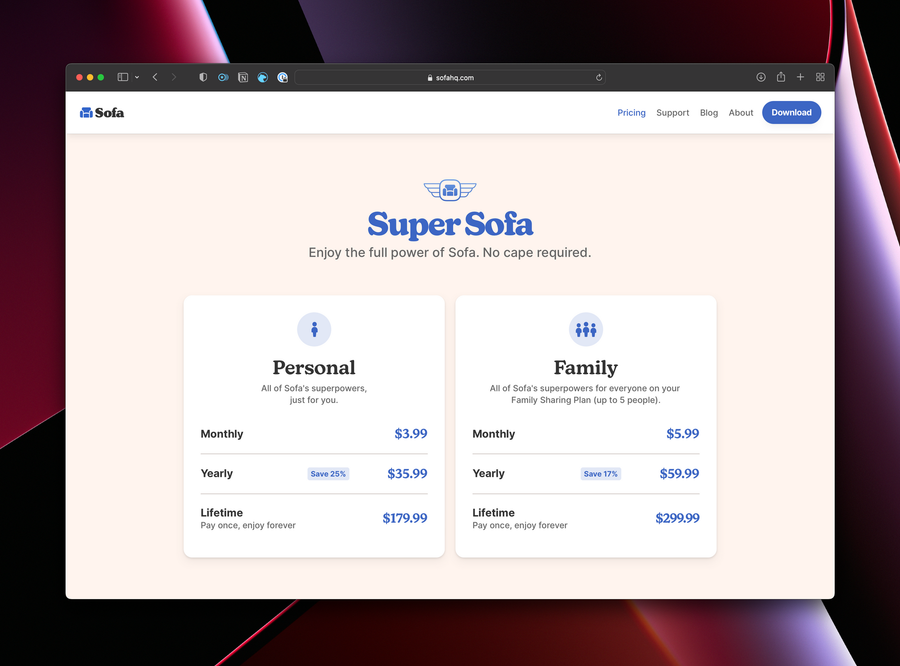Introducing Super Sofa Lifetime Billing

Today I’m introducing a new way of leveling up to Super Sofa, a lifetime billing option. A lifetime billing option is exactly what it says on the tin: pay for Super Sofa once and enjoy the full benefits forever.
This rounds out the Super Sofa offering in a nice way and gives people multiple ways to pay depending on their preference or financial situation.
Personal
For individuals
| Plan | Price |
|---|---|
| Personal Monthly | $3.99 |
| Personal Yearly | $35.99 |
| NEW Personal Lifetime | $179.99 |
Family
For families up to 5 people
| Plan | Price |
|---|---|
| Family Monthly | $5.99 |
| Family Yearly | $59.99 |
| NEW Family Lifetime | $299.99 |
Why am I doing this?
Since Sofa is a subscription business, you may be confused as to why I would offer an option to pay once instead of on a recurring basis. I think it’s helpful to understand some of the arguments against a lifetime option before explaining why I think it’s a good fit for Sofa.
One of the main reasons quoted for not offering lifetime billing is that you’re not capturing the full Lifetime Value (LTV) of a customer. For example, David Barnard recently said on the “How To Not Screw Up Switching Your App to Subscriptions” episode of the SubClub podcast:
“I think we’re just so early and understanding like how long these things are going to go if you’re going to pick off some of your best, highest intent users and charge them 200 bucks, you’re actually probably significantly shortchanging your, true lifetime value.”
So when you take average churn rate and say, my average retention is two years. And so I’m going to charge two X, my subscription, which you’re not accounting for is that it’s actually your best users who are gonna be. Paying lifetime.
Echoed by Curtis Herbert:
https://twitter.com/parrots/status/1404819957578452994?s=61&t=hbfOXy75CXbntMH0X2RypA
While this may be true, this is a bit of a purist approach and a “you’re leaving money on the table” argument. I’m ok with leaving future money on the table if it allows me to grow the business today. This is also assuming that these people subscribe in the first place and stay subscribed for long enough to get the full Lifetime Value (LTV).
I find myself agreeing with this approach from Ryan Jones:
https://twitter.com/rjonesy/status/1404813713534820356?s=61&t=ZUf32x7b3e7Fuj6z2UUKmw
Since Super Sofa only launched in July of 2021, I don’t have enough historical data to pull on. I don’t know what my long-term average retention will be. Also, as a small, growing business, having more cash now is better for the long-term:
Booking that money, like right up front can really mean the difference between, okay. I can hire the next step and like we can kind of ramp what we’re doing as opposed to an annuity, which essentially like an annual subscription where you’re just getting that money like over time.
– Jacob Eiting
Similar to Roon, I plan to increase the one-time price over time to account for Sofa becoming a more mature and healthier business.
We initially offered the lifetime for early commitment, not so people could rent-to-own. The goal was to bring forward 4-5 years of revenue so we could fund the start of the company. It worked. We never raised external funding.
– Roon Lifetime Price Increase
I think the tradeoffs are worth it, but here are the two main reasons why I’m offering a lifetime option:
Open up Super Sofa to more people
Since introducing Super Sofa in the summer of 2021, I have heard from a vocal minority that they would prefer a “lifetime” option for Super Sofa. The reasons for this range from people who are anti-subscription and others who are on a more strict budget.
It’s highly unlikely that the people who fall into these groups will ever subscribe to Super Sofa on a monthly or yearly basis. Since this is revenue I wouldn’t have ever gotten anyway, why not offer a way for these folks to pay for Super Sofa?
Help bootstrap the business
Since I’m not planning on seeking VC money for Sofa, I need to bootstrap the business by charging customers money. Offering a lifetime option could pull forward revenue.
I disagree with that. Lifetime is too lucrative.
I.e. 15% of $100 vs 30% of $100 is still a shit ton *right now*. Versus 15% of $25/yr, praying for 4 years of retention, and time value of money— Ryan Jones (@rjonesy) October 22, 2021
Increased cash flow today really matters. That’s money I can use to put back into the product for new features, improvements, and most importantly, marketing.
What does “lifetime” actually mean?
When it comes to purchasing software, words like “lifetime” and “forever” can be a bit murky. Here’s how I’m defining it…
The life of the app
-
If Sofa goes out of business then its “life” is over and honoring _any_customer purchases would be impossible.
-
A sale or acquisition of Sofa would constitute a “new life” for the product. This isn’t my plan for Sofa, but life is weird, things happen, and it’s helpful to think through many scenarios. I can’t make any promises about new owners honoring lifetime customers forever, but would _strongly_negotiate for them to do so.
The life of the customer
This is a sad thing to think about, but if a customer passes on then honoring their purchase would only be possible if someone took ownership of their Apple ID.
Final Thoughts
There are trade-offs between offering and not offering a lifetime option within a subscription product. For the long-term viability of Sofa, I think it’s worth offering a lifetime option today so that the business has a better chance of existing in the future.
My goal is to grow Sofa into a healthy and sustainable business, and I think offering a lifetime option can help me get there.
You can see the updated Super Sofa plans on the Sofa website.
